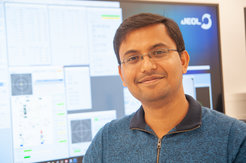A novel strategy to stabilize non-collinear spin textures in van der Waals magnets
A novel strategy to stabilize non-collinear spin textures in van der Waals magnets by self-intercalation.
In a new publication in Nature Communications scientists of the Max Planck Institute of Microstructure Physics and scientists from the Martin Luther University (Halle-Wittenberg), the G. V. Kurdyumov Institute for Metal Physics (Ukraine) and the Johannes Kepler University Linz (Austria) find clear and direct evidence for skyrmions in a member of the family of van der Waals materials, CrTe2, that is nominally centrosymmetric.

Spintronics is a field of research of great fundamental as well as technological interest. The most important applications to date use magnetic materials in which the magnetic moments of the individual atoms are oriented parallel or anti-parallel to one another. Of great interest today are magnetic materials in which neighboring magnetic moments are neither parallel or anti-parallel but are rather non-collinear and can thereby form complex, topological, spin textures. Perhaps the most extensively studied of these is the skyrmion; this is a tiny magnetic nano-object with a chiral magnetic boundary and which is typically circular in shape. A prerequisite for the formation of such chiral nano-objects is that the parent material have a structure that is non-centrosymmetric. What has surprised the spintronics community recently is the observation of skyrmions in several materials that are centrosymmetric.
In a paper published in Nature Communications on July 8th a group of scientists in the NISE department (Nano-Systems from Ions, Spins and Electrons) directed by Stuart Parkin at the Max Planck Institute of Microstructure Physics together with scientists from the Martin Luther University (Halle-Wittenberg), the G. V. Kurdyumov Institute for Metal Physics (Ukraine) and the Johannes Kepler University Linz (Austria) find clear and direct evidence for skyrmions in a member of the family of van der Waals materials, CrTe2, that is nominally centrosymmetric. They show, however, that the symmetry of the structure of this 2D compound is lowered in a very special manner by self-intercalation of Cr atoms within the so-called van der Waals gaps between tri-layers of Te-Cr-Te from which the structure is formed. Furthermore, they demonstrate from detailed, high resolution, x-ray structure analysis that the self-intercalated Cr atoms form an ordered 3D superstructure that hasn’t previously been observed in any known van der Waals compound. The superstructure gives rise to two inequivalent van der Waals gaps, both partially filled by Cr atoms but in different ways. As a consequence, neighboring Te-Cr-Te tri-layers experience an asymmetric environment involving relaxations of the atomic positions along the vertical c-axis, thereby reducing the crystal symmetry from P3m to P3m1, the latter being non-centrosymmetric. The latter has a C3v point group that is compatible with the appearance of Néel-type skyrmions, which were directly imaged using state-of-the-art Lorentz transmission electron microscopy over a wide temperature range (see Figure). Stuart Parkin comments that “Our study reveals that self-intercalation can change the symmetry and consequently the fundamental properties of van der Waals materials, such as their magnetic properties, in unique ways. This is likely common to many of these compounds and is a very interesting strategy for developing and tuning the properties of these highly interesting materials”.
![Figure 1: (a) Un-intercalated CrTe2 with equivalent van der Waals (vdW) gaps [top] and self-intercalated Cr1.3Te2 with two inequivalent van der Waals gaps shown as vdW(1) and vdW(2) [bottom]. The (2×2×2) superstructure in the self-intercalated material is shown by the red dotted line. TL stands for triple layer of Te-Cr-Te. (b) Schematic of Lorentz TEM showing imaging of Néel skyrmions from the thin lamella prepared from a single crystal of self-intercalated Cr1.3Te2. Magnetic contrast of Néel skyrmions appear as circular features that are characterized by dark and bright contrast at their opposite edges. Schematic of Néel skyrmion is shown in the bottom corner.](/652284/original-1660655437.jpg?t=eyJ3aWR0aCI6MjQ2LCJvYmpfaWQiOjY1MjI4NH0%3D--b6837cea1dd779430c45d29ccdc35374e8efad46)
This work was published on July 8, 2022 in Nature Communications (Rana Saha, Holger L. Meyerheim, Börge Göbel, Binoy Krishna Hazra, Hakan Deniz, Katayoon Mohseni, Dmitry Knyazev, Amilcar Bedoya-Pinto, Ingrid Mertig and Stuart S. P. Parkin, “Observation of Néel-type skyrmions in acentric self-intercalated Cr1+δTe2”, Nature Communications 13, 3965 (2022)).

![Figure 1: (a) Un-intercalated CrTe2 with equivalent van der Waals (vdW) gaps [top] and self-intercalated Cr1.3Te2 with two inequivalent van der Waals gaps shown as vdW(1) and vdW(2) [bottom]. The (2×2×2) superstructure in the self-intercalated material is shown by the red dotted line. TL stands for triple layer of Te-Cr-Te. (b) Schematic of Lorentz TEM showing imaging of Néel skyrmions from the thin lamella prepared from a single crystal of self-intercalated Cr1.3Te2. Magnetic contrast of Néel skyrmions appear as circular features that are characterized by dark and bright contrast at their opposite edges. Schematic of Néel skyrmion is shown in the bottom corner. Figure 1: (a) Un-intercalated CrTe2 with equivalent van der Waals (vdW) gaps [top] and self-intercalated Cr1.3Te2 with two inequivalent van der Waals gaps shown as vdW(1) and vdW(2) [bottom]. The (2×2×2) superstructure in the self-intercalated material is shown by the red dotted line. TL stands for triple layer of Te-Cr-Te. (b) Schematic of Lorentz TEM showing imaging of Néel skyrmions from the thin lamella prepared from a single crystal of self-intercalated Cr1.3Te2. Magnetic contrast of Néel skyrmions appear as circular features that are characterized by dark and bright contrast at their opposite edges. Schematic of Néel skyrmion is shown in the bottom corner.](/652284/original-1660655437.jpg?t=eyJ3aWR0aCI6ODQ4LCJmaWxlX2V4dGVuc2lvbiI6ImpwZyIsIm9ial9pZCI6NjUyMjg0fQ%3D%3D--4221e836bf123c80f501b6d46fee239e25894b4c)











